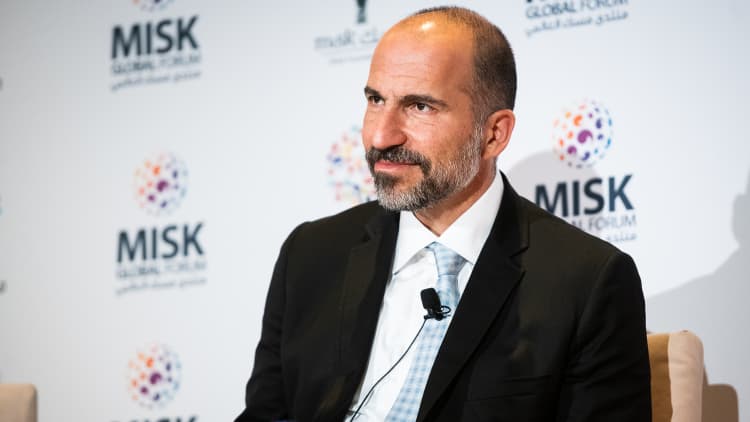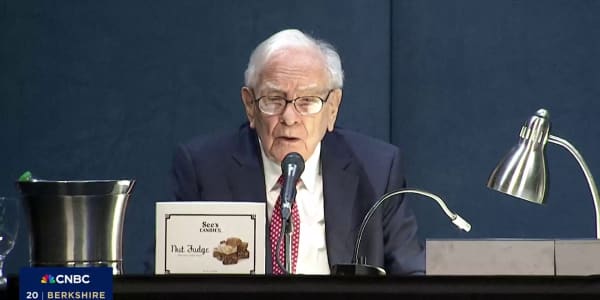As Uber prepares to go public later this week, there is a wild card that could affect its pricing and stock trading when it debuts. The factor goes to the heart of the company's business model: the use of contract rideshare drivers. Uber and its rival Lyft build their businesses on the backs of contract workers who are planning to strike and rally again ahead of Uber's anticipated IPO on Friday. On that day, drivers in a growing number of cities will log off of Uber, Lyft, and Juno's platforms between 7 a.m. and 9 a.m. local time or throughout the day, and they're urging riders to do the same.
The New York Taxi Workers Alliance (NYTWA) is calling on U.S.-based drivers to stand in solidarity with drivers in London and log off from both Uber and Lyft between 7am and 9am. Protests at major transportation hubs and company offices also are scheduled in New York and other cities, such as Los Angeles, San Francisco, Chicago and London. The group Rideshare Drivers United–Los Angeles has helped organize the strike across time zones.
Drivers intend to send a message to Uber that is slated to begin trading as a public company Friday morning. The movement could spark unease among potential investors.
The workers want higher wages and livable incomes, job security and regulated fares, according to sources at the NYTWA, which represents 21,000 professional drivers including those that work for Uber and Lyft. So far, New York City is the first and only market to have implemented a minimum wage law for ride-hail drivers that went into effect Feb. 1. They are to earn $17.22 an hour.
According to industry sources, drivers are dissatisfied and feel the company is profiting by exploiting them. In stark contrast, many Uber executives will become instant millionaires once the IPO hits the Street and starts trading on Friday. The company plans to offer 180 million shares at $44 to $50 a piece putting its valuation at a whopping $91.5 billion. Although Uber plans to give some of its drivers cash bonuses, it is viewed as a workaround since SEC rules prevent giving private stock shares to freelancers.
In a statement an Uber spokesman said "the company is continuing to work to improve the experience for drivers, on and off the road," told CNBC in an email. "Whether it's more consistent earnings, stronger insurance protections or fully-funded four-year degrees for drivers or their families, we'll continue working to improve the experience for drivers." The spokesperson said the company could not comment on any questions related to its IPO.
The gig conundrum
Worker classification has become a hot-button issue on the state and federal level as the number of gig workers rises in the U.S. to approximately 57 million people. Fortunately for Uber and Lyft, the courts have largely agreed that their drivers don't count as full-time employees. And last Monday, in a case involving an unnamed company, the Department of Labor issued an opinion that gig workers are to be classified as independent contractors, not entitled to health insurance and other benefits that would force companies to follow federal minimum-wage laws.
That key decision was a blow to independent contractors looking for support from the federal government, and now there is movement among some blue states, such as California, toward more restrictive worker-classification laws that would make it harder for employers to treat their workers like independent contractors.

This simmering issue has blown up for Uber and other companies that use gig workers already. A recent example is the $20 million Uber agreed to pay in March to settle a class-action lawsuit over worker misclassification, initially brought by independent contractors who drove for the platform in California and Massachusetts.
In a May 2 court decision in California, the Ninth Circuit Court of Appeals ruled that the "ABC Test" — which in 2018 established a strict test for whether workers could be considered contractors — applies retroactively in the state. The California Supreme Court put in place the three-part test in a decision in April 2018 in the case Dynamex Operations West v. Superior Court, which was brought by janitorial workers with a claim against Jan-Pro International Franchising.
"This may cause some implications for Uber and other gig-economy services," says Alexandrea J. Ravenelle, an assistant professor of sociology at Mercer College, who recently published "Hustle and Gig: Struggling and Surviving in the Sharing Economy," a book investigating the situation of gig workers. "It could lead to more lawsuits."
The test says that an employer who wants to classify someone as a contractor must prove three things: (1) that the worker is free from the control and direction of the hiring entity in performing the service; (2) the worker performs work outside of the usual course of the employer's business or [except in some states including California or Massachusetts] outside the employer's place of business; and (3) the worker is customarily engaged in an independent trade, occupation or business that is the same kind being performed for the employer.
The most difficult part of test — determining if the work is outside of the usual course of business — is typically determined by courts based on the services the employer advertises, says attorney Mark Zisholtz, a partner at BakerHostetler, in Atlanta who has consulted with platforms that utilize drivers to implement their business model.
In addition to California, the ABC test has currently been adopted by Connecticut, Indiana, Massachusetts and New Jersey when it comes to determining who is eligible for overtime, and there is a bill pending on whether to adopt it in the state of Washington. When it comes to unemployment compensation, about half of the states in the U.S. use the ABC test to determine eligibility.
"It hasn't yet been applied to ride share drivers," says Steve King, partner at Emergent Research in Lafayette, Calif., which studies independent workers. "If it is, it would definitely find them misclassified."
But not all states see the issue the same way and some red states, such as Texas, have adopted laws codifying that the drivers are independent contractors.
"It's being decided on a state-by-state basis," says Sophie Wade, workforce innovation specialist at Flexcel Networks, a firm that advises companies on how to prepare for the future of work, and author of Embracing Progress. "We are in a messy period where we haven't yet worked all of the kinks out."
A Pandora's box
Nonetheless, a lot would have to change for Uber to classify its drivers as employees and change its business model.
The only thing that would likely lead Uber to classify workers differently would be litigation threats, says Zisholtz. "It would have to be enough to move the needle on the bottom line for Uber," he says.
Shareholders who buy stock after the IPO would have little incentive to push Uber to classify its workers as W-2 employees, according to Micah Rowland, COO, of Fountain, a hiring platform that serves the on-demand economy and other industries.
"It would have a significant cost implication if they were to reclassify their drivers as employees," says Rowland. "I think that would have adverse impacts on their business's growth and profitability. It would make them more unprofitable to classify them as W-2 employees, not contractors. I don't think there would be shareholders pushing for such a thing."
Ravenelle, however, believes it is possible that shareholders could put pressure on Uber in the future to classify its drivers as W-2s. "There could be some movement to change what Uber is doing when there are shareholders involved and there is more attention," she says.
Classifying the drivers as employees would likely affect full-time drivers positively, but could hurt the many who are part-timers, according to Yevgeniy Feyman, who drove for Uber part-time to make extra money while working as a policy researcher at Harvard University in 2016 and 2017.
"For people who are driving 60 hours a week being classified as employees would be very, very useful," says Feyman. "Unless they are in a two-income household and have health coverage through their spouse, they are probably not getting health coverage from anyone else and have to buy it on the exchanges."
But it might hurt drivers who work part-time for the service, he says. "They would probably see their earnings shrink quite a bit," says Feyman. "Ultimately, Uber might try to figure out a way to cut some people who don't drive a lot and try to encourage those who do drive a lot to drive more. The cost of having part-timers that are classified as employees probably isn't worth it, relative to someone who is putting in a lot of hours."
New worker classification
Wade ultimately sees the discussion shifting toward a new type of worker classification as proposed by The Hamilton Project, a think tank within the Brookings Institution. The new classification would be a hybrid between a 1099 worker and a W-2, enabling employers to give 1099 workers certain benefits without reclassifying them as W-2s and grants the workers collective bargaining rights.
Given that more people are becoming freelancers — including many who do not want to be employees — the idea of decoupling health and other benefits from employment and making them portable is picking up traction, Wade notes.
So is creating more of a social safety net for freelancers that takes into account challenges like saving for retirement with an unpredictable income, she says. "All of these things that have supported everyone in full-time jobs aren't there," says Wade. "As we move toward more freelance and part-time work being integrated with most people's careers, these things need to be in place."






